When it comes to fat loss and muscle gain, everyone wants Insta-worthy after photos… right now. But understanding what’s realistic can be the difference between achieving amazing results and giving up altogether. How fast can a client lose fat? What’s the upper limit of muscle gain? And how do you figure out a rate of progress that your client can not only achieve but sustain? We have the numbers—and your coaching game plan.
+++
Imagine you have two new clients.
Courtney—a 34-year old female—wants to lose the extra 30 pounds she’s packed on since college.
Jose—a 27-year old male—wants to add 15 pounds of muscle to his frame.
Like many clients, they both say they’re ready to do whatever it takes.
Knowing all this, how long should it take each to achieve their goals?
A. 3 months
B. 6 months
C. 1 year
Answer: It depends.
Each option may be doable, but all three come with tradeoffs. And unless you help Courtney and Jose fully understand this—and set their expectations appropriately—they’re likely to end up disappointed.
Sound familiar?
When it comes to losing fat or gaining muscle, people are often frustrated by what they think are “poor” or “mediocre” results.
Not due to lack of progress, but because:
- They started with unrealistic expectations
- They couldn’t sustain their initial rate of progress
- All of the above
It doesn’t have to be this way.
In this article, we’ll share what realistic rates of both fat loss and muscle gain look like, based on a combination of clinical evidence and our work with over 150,000 clients.1, 2
More importantly, we’ll show you how to determine a rate of progress that’s right for your client (or even yourself). For results that meet expectations—every single time.
But… if you want to jump right to the numbers, click the links below:
Otherwise, keep reading (the details matter) for the complete story.
(Want more health, nutrition, and coaching insights? Sign up for our FREE weekly newsletter, The Smartest Coach in the Room.)
Results not typical… or are they?
Let’s say Courtney lost six pounds of body fat in your first four weeks together. Yet she was disappointed in her “lack” of progress.
From our standpoint, her progress was fantastic.
Over six months, maintaining that rate of progress would lead to a 40-pound fat loss.
That could be life-changing for some. For others, it might be way more than they’d even want to lose. (In fact, it’s more than Courtney wanted to lose.)
Yet all too often, the client thinks they’re failing. Because six pounds in four weeks doesn’t feel like a lot.
This is likely because they expected extremely rapid results. Perhaps they hoped to quickly look like they did 15 years ago or have the body comp of a magazine cover model… by next month’s vacation.
Now, most people would readily admit that expecting to lose 15 pounds of fat or gain 10 pounds of muscle in two weeks is unrealistic. (The same goes for correcting serious blood lipid issues or knocking a half-second off their 40-yard dash time.)
But subconsciously, they still want to believe these results are not only possible but likely. After all, they’ve seen The Biggest Loser.
Your job: Set achievable expectations from day one.
Understand the true goal and what success looks like.
This starts by finding out what your client ultimately hopes to achieve.
- Do they want to lose a few pounds and get healthier?
- Do they want to look fit in clothes?
- Do they want to pack on 15 pounds of muscle?
- Do they want to be “shredded,” with visible abs?
Make sure you have a shared understanding of what they’re envisioning.
You want to be in complete agreement. So ask more questions and dig deeper.
‣ If they say they want to lose 20 pounds, what do they picture? Many people underestimate how much fat they’d have to lose to achieve a certain body composition. They might think they need to drop 20 pounds, when in fact, it’s more like 40.
‣ If they want to “get healthier,” how will they know when they arrive? Are they picturing better blood work, and if so, what specific measures are they concerned about?
‣ If they want to gain muscle, are they okay gaining some fat, too? Do they see themselves as The Rock, or just a slightly bigger version of themselves?
‣ If they want to “look muscular,” getting leaner might help them achieve that goal faster. As the saying goes, “Losing fat is the fastest way to look bigger.”
‣ If they want a six-pack, are they prepared for all that entails? Achieving this type of physique often requires a greater amount of exercise, a more restrictive diet, and a less flexible lifestyle. What’s more, if they’ve been over-fat for a long time, it could come with some loose skin.
Walking clients through their desired scenario can help them better choose a path based on what’s most important to them.
Make sure the tradeoffs are crystal clear.
Simply put: You want your client to know what they’re getting into.
An effective way to do this: Put your client’s desired outcome on a continuum next to two (or more) other outcomes.
If you want to highlight how unlikely or difficult the goal will be, show what it’ll take to achieve two easier goals.
You could say: “Here are the tradeoffs that you’ll need to make to reach your goal, and for comparison, here’s what two other outcomes might require. Do those tradeoffs feel acceptable to you?”
On the other hand, if you want to give the client more confidence, you might sandwich their goal between one that’s easier and one that’s harder.
You could say: “There’s no doubt your goal will be a challenge, but at least you can eat dessert most days and still achieve it. What do you think about that?”
Here’s an example of how this might look. The illustrations that follow show the tradeoffs typically required to achieve three different levels of body fat.
As you can see, the lower your body fat percentage goal, the greater the commitment that’s required. (For a deeper dive on this topic, read: The Cost of Getting Lean.)
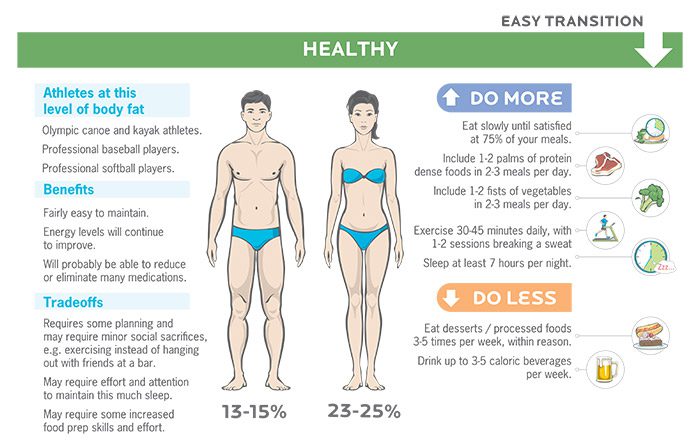
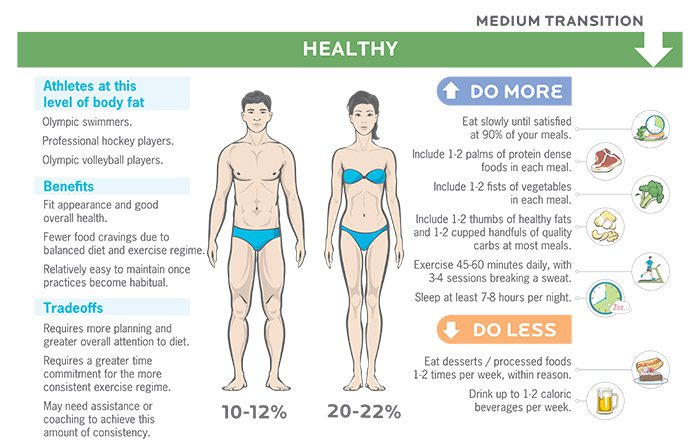
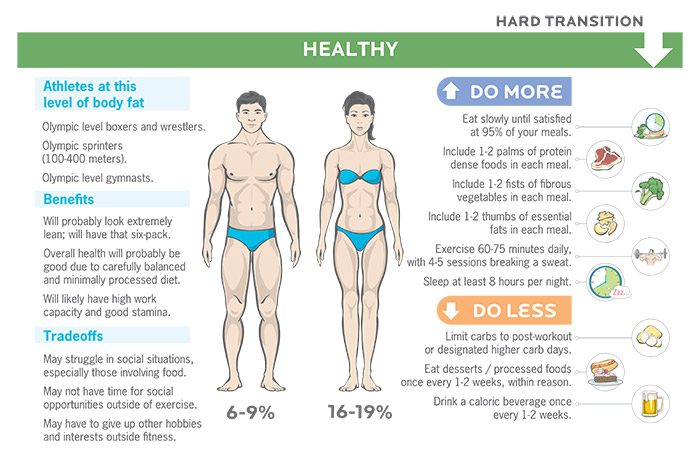
To ensure both you and your client understand what they want to achieve, and what they’re willing (and not willing) to do to achieve it, download and use the Want-Willing-Won’t Worksheet.
Now it’s time to talk timelines. We’ll cover realistic rates of fat loss first, followed by realistic rates of muscle loss.
Realistic rates of fat loss.
How fast you can lose body fat depends on how consistently you can, or want to, follow the guidelines you’re given.
Realistic rates of fat loss per week
| Progress | % Body Weight | Men | Women |
|---|---|---|---|
| Extreme | 1-1.5% body weight | ~2-3 lb | ~1.65-2.5 lb |
| Reasonable | 0.5-1% body weight | ~1-2 lb | ~0.8-1.65 lb |
| Comfortable | <0.5% body weight | ~<1 lb | ~<0.8 lb |
Here’s how to quantify each of these categories:
Extreme: Requires about 90 to 100 percent consistency.
Reasonable: Requires about 70 to 85 percent consistency.
Comfortable: Requires about 50 to 65 percent consistency.
(Note: You could also create a comfortable rate of progress in which you’re highly consistent. Your initial action plan would simply require you to make fewer changes than what’d be necessary to achieve reasonable or extreme rates of progress.)
Clearly, the more consistent you are, the faster your progress, and the more fat you’ll lose.
It’s also important to realize that fat loss is rarely linear. It fluctuates from day to day and week to week. The goal is to see an overall trend downward over time.

But… fat loss is often fastest when:
- You’re first starting out
- You have more body fat to lose
Why? Suppose you normally eat 3,500 calories per day and are maintaining your body weight. If you suddenly start eating 2,000 calories a day, you’ve created a massive deficit of 1,500 calories. That’ll lead to rapid weight loss.
Once you start to lose body weight, however, this deficit becomes smaller and smaller, slowing fat loss. (Because a smaller body requires fewer calories.)
As this process continues, your metabolism adapts, lowering your calorie needs even more than what you’d expect from the weight loss alone. You’ll also become more efficient at exercising, reducing the number of calories you burn through movement.
And if that’s not enough, you might even exercise less frequently and intensely because you now have less energy coming in. (To learn more, read: How your metabolism adapts as you lose weight.)
The upshot:
The leaner you become, the slower your rate of fat loss, and the more plateaus you experience.
This is normal. And helping clients understand this leads to better progress.
That’s because they’ll be less likely to throw in the towel when fat loss stalls for a week or two. Instead, they’ll understand it’s a normal part of the journey.
Encourage clients to think of fat loss like a long road trip. If they know going in that they’ll have to stop for food and bathroom breaks, and that they’ll probably experience some traffic jams and construction detours, they won’t be dismayed when those things happen. (Because they will. That’s life.)
It won’t always be smooth sailing. Coach them to expect disruptions ahead of time. This mental preparation will be valuable down the road.
Realistic rates of muscle gain.
The ability to gain muscle is dependent on age, biological sex, genetics, and consistency with food intake, along with resistance training experience, intensity, frequency, style, volume, and more.
Realistic rates of muscle gain per month
| Fitness level | Men | Women | ||
|---|---|---|---|---|
| Beginner | 1-1.5% body weight |
~1.5-2.5 lb | 0.5-0.75% body weight |
~0.65-1 lb |
| Intermediate | 0.5-0.75% body weight |
~0.75-1.25 lb | 0.25-0.375% body weight |
~0.325-0.5 lb |
| Advanced | 0.25-0.375% body weight |
~0.375-0.625 lb | 0.125-0.1875% body weight |
~0.1625-0.25 lb |
Much like fat loss, muscle gain is often not linear. Progress seems to come in fits and spurts, especially after the first year of dedicated training.
It’s not uncommon to see young men gain 15 to 25 pounds of muscle in their first year of dedicated training (beginner), and another 10 to 15 pounds in their second year (intermediate).
Young women can see gains of 8 to 12 pounds of muscle in their first year of dedicated training (beginner), along with another 4 to 6 pounds in their second year (intermediate).
After the first three or so years of dedicated training (advanced), it often takes years of persistent effort to see incremental gains.
So over the course of a lifting career, men have the potential to gain about 40 to 50 pounds of muscle, and women have the potential to gain about 20 to 25 pounds of muscle. (Depending on height, bone structure, and genetics—and without the help of performance-enhancing drugs.)
For the realistic rates of muscle gain shown here, the emphasis is on “young” men and women under the age of 30. Testosterone and other sex hormones are higher during this time of life, as is cellular turnover and overall recovery capacity. All are key factors for muscle growth.
Older men and women usually add less muscle and/or at a slower rate, due to changes in these variables.
Can you still gain significant muscle after your 20s? Yes, but for the most part, this depends on whether or not you still have a fair amount of room to reach your 40 to 50 pound (men) or 20 to 25 pound (women) potential.
Identify a likely rate of fat loss or muscle gain for each individual.
Consider the realistic rates of fat loss and muscle gain the upper limit of what can be achieved in a given time frame. Now you have to adjust that number, based on the person and conditions you’re working with.
This is where the art of coaching really comes in.
The rate of body composition changes can be affected by the following factors.
Factors that make fat loss harder or easier
| What makes fat loss harder | What makes fat loss easier | |
|---|---|---|
| Age | Being older* | Being younger |
| Sex | Being female | Being male |
| Current body size | Being smaller | Being heavier |
| Current body composition | Being relatively lean | Having more body fat |
| Current activity level | Little to no activity | High levels of activity |
| Current activity type | Doing excessive cardio without other types of activity | Having a well-rounded exercise regimen |
| Consistency | Being inconsistent | Being consistent (>80%) |
| Recovery | Sleeping less than 7 hours most nights | Sleeping at least 7-8 hours most nights |
| Stress | Excessive stress or perception of excessive stress | Appropriate stress levels or perception of appropriate stress |
| Hormones | Leptin-resistance / low leptin Insulin-resistance |
Hormones in healthy ranges |
| Medication | Birth control Corticosteroids Antidepressants |
Xenical / Alli Belviq Qsymia Contrave Saxenda PEDs |
| Health status | Menopause Hypothyroidism PCOS Cushing’s syndrome Depression |
Clean bill of health |
*Fat loss can and does occur at any age. The reasons it can be harder for older folks may be more age-related (health status, medications, mobility) as opposed to age-dependent.
Factors that make muscle gain harder or easier
| What makes muscle gain harder | What makes muscle gain easier | |
|---|---|---|
| Age | Being older (>40) | Being younger (<30) |
| Sex | Being female | Being male |
| Current body size | Having a small frame / bone structure | Having a large frame / bone structure |
| Current body composition | Having more body fat | Being relatively lean |
| Current activity level | Little to no activity | Moderate levels of activity |
| Current activity type | Inadequate resistance training / excessive cardio | Resistance training |
| Consistency | Being inconsistent | Being consistent (>80%) |
| Recovery | Sleeping less than 7 hours most nights | Sleeping at least 7-8 hours most nights |
| Stress | Excessive stress or perception of excessive stress | Appropriate stress levels or perception of appropriate stress |
| Hormones | High cortisol | Hormones in healthy ranges |
| Medication | Thyroid drugs ADHD drugs Acne medication |
PEDs |
| Health status | IBD Gastroparesis Hyperthyroidism Depression |
Clean bill of health |
These are by no means exhaustive lists, but are good examples of how additional factors can impact an individual’s rate of progress.
You also need to account for what else is happening in a person’s life.
Will your client improve at a consistent rate or might there be periods where progress slows?
For example, if they’re an accountant, you may need to adjust expectations during tax season. During the holidays, the goal might just be to maintain current progress, then aim to make further progress after the holidays have passed. And what about upcoming vacations or other planned breaks?
You can’t foresee every issue, but you can plan for what you know.
For these periods, ask your client how little improvement they’re willing to accept and how long they expect these periods to last. Together, you can incorporate that information into the timeline.
Once you have a good idea of where they want to go and how fast they could get there, it’s time to fully review what’s required. Is your client “ready, willing, and able” to do what it takes?
You can test this by using the Ready, Willing, and Able Worksheet.
This is where you find out how realistic the rates of progress truly are, based on the action plan you create with your client.
Now that the next steps are in front of them, how confident are they about following through? Remember: The key to success is consistency. (Learn more: How to create a plan clients can do consistently.)
If your client isn’t ready, willing, able to follow through consistently, that’s okay. You’ll simply need to adjust their action plan. And that also means adjusting their expectations.
But that’s good news: With this approach, you’ll both be on the same page from the get-go.
Revisit and re-calibrate expectations as data accumulate.
No one can perfectly predict a client’s rate of progress. This exercise simply gives you a way to measure if your client is moving in the right direction at their desired rate, or if their outcomes are falling short of expectations.
In general, you should monitor results for two weeks before recommending your client adjusts their food intake or action plan.
And as they become more advanced, or progress closer to their final goal, it may take a full four weeks to see if their intake is working. Give it an appropriate amount of time before considering further adjustments.
As you gather data, and choose next actions based on that data, continually review and revise your clients’ plans and expectations. (Click here to download a printable guide that lets you reference the information below at a glance.)
Not losing fat within realistic parameters?
Decrease your client’s intake by about 250 calories a day, by cutting out about 25 to 50 grams of carbs and/or 7 to 15 grams of fat. Or simply remove 1 to 2 cupped handfuls of carbs and/or 1 to 2 thumbs of fats from their daily intake. (That’s 2 to 3 total portions of carbs and fats, combined.)
Not gaining muscle within realistic parameters?
Increase your client’s intake by about 250 calories a day, by adding 25 to 50 grams of carbs and/or 7 to 15 grams of fats. Or simply add 1 to 2 cupped handfuls of carbs and/or 1 to 2 thumbs of fats to your daily intake. (That’s 2 to 3 total portions of carbs and fats, combined.)
Losing too much lean mass when losing weight?
Increase your client’s daily protein intake by about 25 grams. Or simply add 1 extra palm of protein to your daily intake.
Gaining too much fat when adding muscle?
Increase your client’s daily protein intake by about 25 grams, and decrease their daily carb intake by about 25 to 50 grams and/or fat intake by about 7 to 15 grams.
Or simply add 1 extra palm of protein to your daily intake, and remove 1 to 2 cupped handfuls of carbs and/or 1 to 2 thumbs of fats from your daily intake. (That’s 2 to 3 total portions of carbs and fats, combined.)
Not recovering from tough workouts or competitions?
Use these four steps:
Step 1. Review your overall daily energy intake. If you’re cutting calories stringently to lose fat or weight, consider increasing energy intake by 100 to 200 calories so that you’re eating at just a slight deficit.
Step 2. Review your total daily protein intake. Just adding 25 more grams or 1 more palm of protein per day can make a difference.
Step 3. Review your total daily carbohydrate intake. You may need more than you’re getting, particularly right after training sessions or games/competitions. A good start: Add 25 to 50 grams (or 1 to 2 cupped handfuls of carbs) to your daily intake.
Step 4. Review your total daily fat intake, particularly your intake of essential fatty acids. If you’re noticing a lot of inflammation, you might benefit from increasing your intake of “Eat More” fat sources, and decreasing your intake of “Eat Less” fat sources. (See a variety of both sources in the article: What Foods Should I Eat?)
Let the facts guide you.
Clients may progress faster or slower than you expected, or they may encounter unexpected challenges (such as an injury or illness).
This is absolutely okay. Base predictions and expectations on known data, not imagination, hopes, or assumptions.
As the great psychotherapist Carl Rogers once said, “The facts are friendly.” No matter what happens, consider this calibration an essential and valuable part of helping you become a more accurate and evidence-driven coach.
This type of outcome-based decision making is a powerful coaching tool for helping clients see how their actions lead to progress and results.
Remember, numbers aren’t the only way to measure progress.
It can be tempting to focus only on quantitative data: body fat percentage, inches lost, the number on the scale. But progress is just as much about subjective measures, such as:
- Showing up and making any effort, no matter how small
- Tiny actions that are just a little bit better than before
- Feeling more at ease with food
- Daily wins, like having breakfast on your busiest morning
- Having more energy and vitality
- Getting stronger and/or fitter
- Feeling more confident in one’s body or sense of self
- And more
Make sure your client understands how far they’ve come, no matter what the numbers show. Regularly pointing out the bright spots—especially in behaviors, actions, and mindset—gives the client positive feedback they can build on.
The Looking Back, Looking Ahead Worksheet is often super helpful in this regard. It’s a way for clients to see how far they’ve come, which can boost their confidence and keep them motivated. It can also help them proactively work around potential obstacles.
As we say here at Precision Nutrition:
It’s about progress, not perfection.
And whether your clients want to lose fat or gain muscle, that may be the most important expectation you can set.
References
Click here to view the information sources referenced in this article.
If you’re a coach, or you want to be…
You can help people build sustainable nutrition and lifestyle habits that will significantly improve their physical and mental health—while you make a great living doing what you love. We'll show you how.
If you’d like to learn more, consider the PN Level 1 Nutrition Coaching Certification. (You can enroll now at a big discount.)



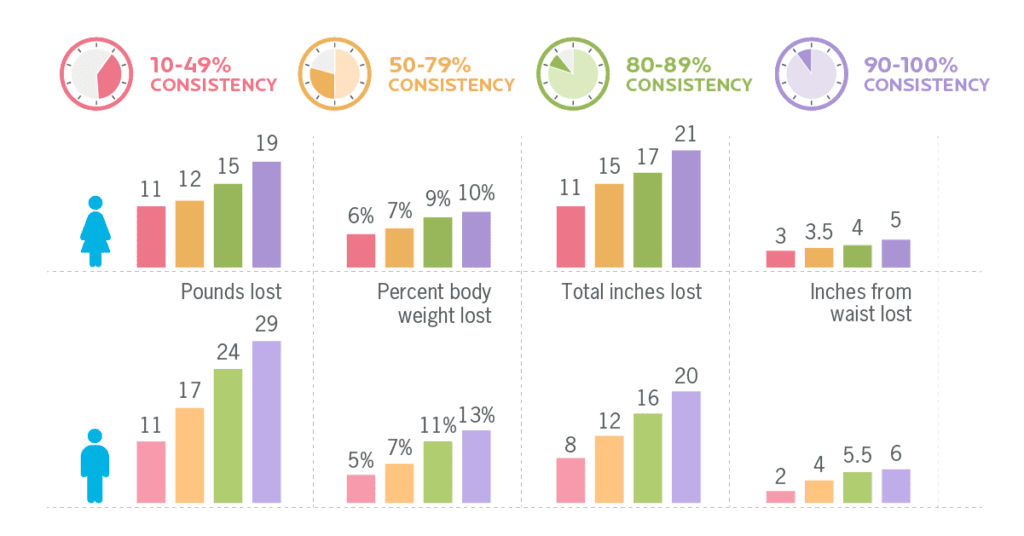
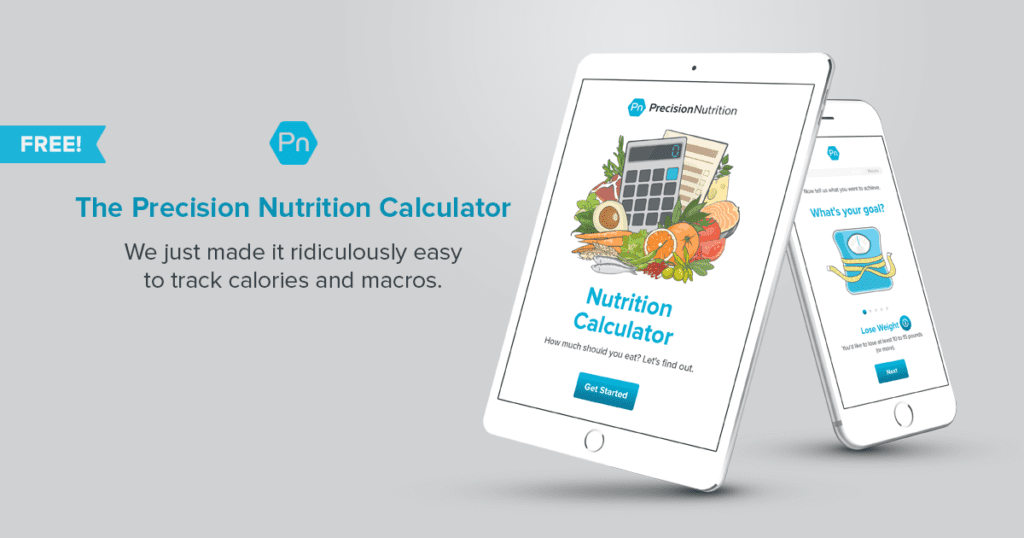
Share